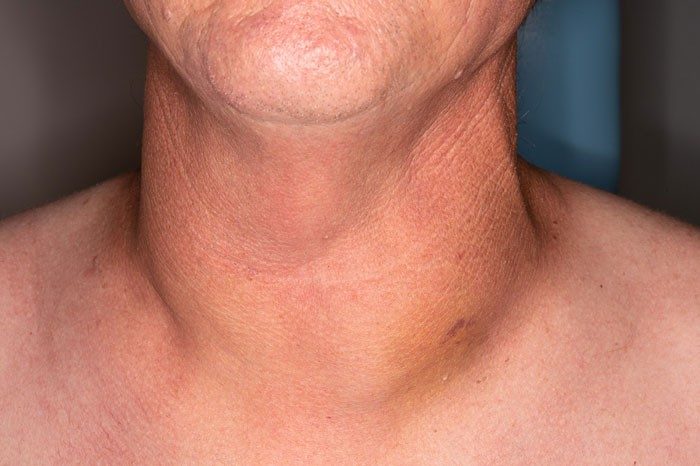
Thyroid nodules are a common abnormality that has been found. It has been found that there is an increasing incidence of new patients with “thyroid cancer”. It is also at risk of spreading to other organs such as lymph nodes and bones. What are the risks? What are the warning signs of the disease?
The thyroid gland is a gland located at the front of the neck. When abnormal, it will enlarge and appear as a lump. Sometimes it is seen as a single lump. Sometimes it grows as several lumps stuck together. Importantly, the lumps that occur on the thyroid gland will move up and down as we swallow saliva. Abnormalities in the thyroid gland are found more frequently than in other groups. Therefore, it is very important for the doctor to provide a differential diagnosis in order to plan the correct and appropriate treatment. Patients with this condition
A single lump on the thyroid gland can indicate the following diseases:
- Benign thyroid tumors (thyroid adenomas) account for approximately 20-30 percent of cases.
- Concomitant benign thyroid nodules
- Thyroid carcinoma is found in 10-15 percent of cases. In the early stages, it is a single, small lump that gradually grows เล่นเกมคาสิโน UFABET ทันสมัย ฝากถอนง่าย before spreading to multiple lumps in the thyroid tissue or spreading to other places, such as lymph nodes or bones, etc.
- Goiter or nodular goiter (50-60 percent of solitary nodules in the thyroid gland have abnormalities in the goiter group.
Thyroid cancer is a disease in which cells in the thyroid gland change into malignant tumors. Thyroid cancer usually starts as a lump in the thyroid gland, then the lump gradually grows. As it grows, the cancer may spread to form a lump on the side of the neck or lumps in other parts of the body, such as the head, ribs, hips, etc. Some people may have a hoarse voice or the lump grows so large that it is difficult to breathe.
Thyroid Cancer Signs
In the early stages, thyroid cancer often has no symptoms, except for a lump in the thyroid gland. Therefore, if a lump is found at the front of the neck that moves up. And down with the swallowing of saliva, you should see a doctor. The doctor will use a small needle to extract cells from the thyroid gland for examination (fine needle aspiration), which can help in the diagnosis of the disease. This method has an accuracy of about 90% and may not find cancer cells, but it could be a thyroid tumor or goiter.
Symptoms indicating a high chance of cancer
- The lump is growing rapidly.
- Having a hoarse voice and difficulty breathing
- Having trouble swallowing, choking
- I felt another lump on the side of my neck.
- Have a family history of cancer or have received radiation therapy before.
- Under 16 years old or over 60 years old with a lump in the thyroid gland
The removed thyroid gland is sent to a pathologist for detailed microscopic examination. If the cancer cells are found to have spread or are likely to have spread to other organs, the patient will be advised to receive additional radioactive iodine treatment.
Surgical complications
- Hoarseness due to injury to the nerves supplying the larynx
- Postoperative hypocalcemia
Both conditions can actually occur during surgery, but if the surgery is performed by an experienced surgeon, the chances of permanent abnormalities from both conditions are very low (less than 1%). Current treatment for thyroid cancer is very effective and has a high chance of being cured, especially for papillary and follicular thyroid cancers, because the treatment responds well to surgery and the use of radioiodine, and patients have a survival rate of more than 95% after 10 years.
Thyroid examination
Currently, the examination of thyroid nodules using high-resolution ultrasound is the most appropriate and effective method because the examination of high-frequency sound waves can provide good information about lesions in the thyroid gland, which is a superficial organ, such as providing details of the size, echogenicity texture of the thyroid gland, details of surrounding organs, and can also be used to find the location for drilling to examine for pathological cells.
It can be seen that in the early stages of cancer, there are usually no symptoms. Therefore, it is important to pay attention and observe yourself. If you find even the slightest abnormality, you should see a doctor immediately.